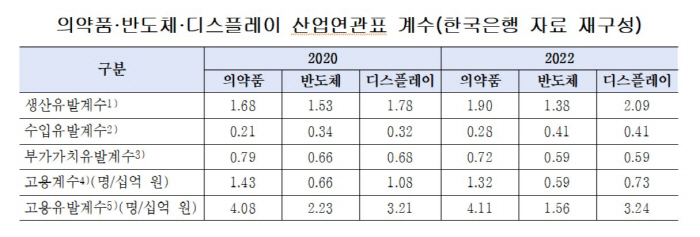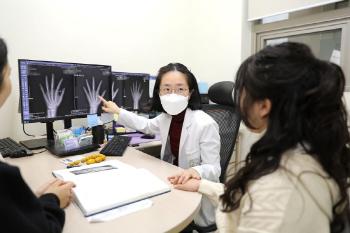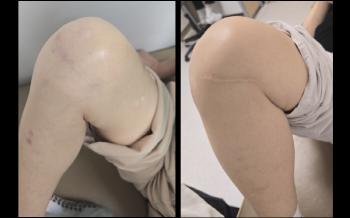Domestic pharmaceutical industry has higher value-added and job creation effects when investing the same amount than semiconductor and display industries
|
According to a report titled 「Study on the Performance and Development Direction of the Korean Pharmaceutical Bio Industry」 conducted by the Korea Institute for the 80th anniversary of the foundation of the Korea Pharmaceutical Bio Association」, a quantitative analysis of the relationship between the three national high-tech strategic industries, including semiconductors, displays, and pharmaceuticals, was conducted using the 2020 and 2022 industry association tables presented by the Bank of Korea. As a result of a comparison between the three national advanced strategic industries except for the secondary battery industry, which cannot be verified in the Bank of Korea's industry association table, the production inducement effect was identified in the order of display-pharmaceutical-semiconductor.
In particular, the pharmaceutical industry has an absolutely small industry size compared to semiconductors and displays, so the economic effect will be small if 1% investment in each industry is assumed, but the results will be significantly different if the same amount is invested.
Specifically, the value-added inducement effect created when 500 billion won is invested in each industry is 360 billion won based on the Bank of Korea's coefficient in 2022, creating about 1.22 times more added value than the semiconductor and display industries. It is also explained that the employment inducement effect is 2055 people, which can be interpreted as 2.6 times higher than that of the semiconductor industry and 1.26 times higher than that of the display industry.
The research report also analyzed the effects of contributing to medical financial savings after the release of generic drugs and drew policy implications by analyzing the case of Tamiflu (component name oseltamivir), a representative original drug for influenza commonly referred to as flu, based on the fact that major countries are working to promote the use of generic drugs to strengthen medical financial soundness.
Tamiflu's domestic patent (composition), which was approved by the Ministry of Food and Drug Safety as an influenza treatment in 2000, expired in August 2017, followed by competition for the release of generic drugs, and the original Tamiflu's drug price was cut one after another. The report estimated that Tamiflu drug prices were reduced by 40% after entering generics, and at the same time, the spread of generic use saved a total of 128.3 billion won (34.7% of the average financial savings compared to the original single prescription) over the five years from 2019 to 2023. In particular, the report analyzed that by expanding the supply of generic drugs during the flu pandemic from 2017 to 2024, benefits such as access to national medical care and treatment opportunities increased and contributed to easing the financial burden. He also said that generic drugs substantially contribute to the public health system in many ways, such as strengthening the ability to respond to infectious diseases in Korea, improving financial efficiency of health insurance, and improving drug access.
The research team also estimated the social welfare effects of domestic drugs by taking the case of peptic ulcer (gastric ulcer and gastroesophageal reflux disease) treatment, which is easy to secure data among the top five drugs in Korea on average for three years from 2022 to 2024 and has developed new drugs (K-Cap, Pexuclu, Jacubo, etc.) by Korean companies. As a result of analyzing the correlation between the prescription amount of the treatment, the number of patients with digestive diseases, and treatment costs over the past 10 years, it was evaluated that an increase of 1 million won is effective in reducing the demand for medical use for digestive diseases, such as a decrease in the number of days of visits to related hospitals and insurance claims by 3.0 days and 2.9 cases, respectively.
The report also pointed out that the Korean pharmaceutical bio industry not only promotes the health of its citizens through vaccines, but also contributes to preventing infectious diseases and improving international public health by stably procuring and supplying vaccines to developing and low-income countries.
The total distribution of the domestic vaccine market in 2023 was 506 billion won, an increase of about 52% compared to 2019. Among them, domestic production performance was 321.9 billion won, growing 16.3% annually over the past five years. In addition, the self-sufficiency rate of vaccines eligible for vaccination in the country rose to 63.6% in 2023 from 52.8% in 2019, reducing some of the import dependence on key vaccines.
However, it is pointed out that 11 out of 22 vaccination vaccines are still dependent on strategic imports, so localization development is necessary. In response, the report analyzed that major domestic vaccine manufacturers are contributing substantially to international public health by securing WHO PQ (Prequalification Assessment) certification, entering the international procurement market, and exporting self-developed products. As related examples, GC Green Cross ▲ GC Green Cross, which has accumulated more than 300 million doses of GCFLU, has been supplied exclusively to WHO and UNICEF as the world's only cholera vaccine supplier, SK Bioscience, which succeeded in listing the WHO's emergency use approved vaccine list and establishing a global partnership (CEPI, BMGF, etc.).
Jeong Ji-eun, an associate researcher at the Korea Institute of Industrial Economics and Trade, stressed that investment expansion from a mid- to long-term perspective is necessary as the pharmaceutical bio industry, which contributes to creating high added value and expanding employment, also contributes to improving public health and reducing public finances. In addition, the provision of an appropriate compensation system or preferential treatment system should be considered so that companies can induce innovation and production by securing technological performance and supporting joint development in areas with low profitability, such as vaccines, rare and incurable disease treatments, and raw materials", he suggested.
This article was translated by Naver AI translator.




